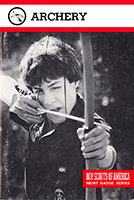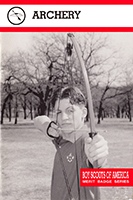
Fig. 1: Archer-H5-Front
- Embroidery: Rayon thread
- Border: Merrowed

Fig. 2: Archer-H5-Reverse
- Back: Molded plastic

Fig. 3: Archer-H5-mve1-front
- Minor variation: Yellow border

Fig. 4: Archer-H5-mve1-reverse
- Back: Molded plastic
Item Name: Archery 1990 - 2002
Item ID: Archer-H5
Collector Rating: 1
Requirements September 1987 until August 1992
1. Do the following:
(a) Name and explain the archery safety rules.
(b) Tell about the local and state laws on ownership, use, and registration of archery tackle.
2. Do the following:
(a) Name and point out the parts of an arrow.
(b) Name and point out the parts of a bow.
(c) Describe and show how to use an arm guard, shooting glove, finger tab, and quiver.
3. Do the following:
(a) Explain proper care of and how to store the bow, bowstring, arrows, and leather items.
(b) Make a bowstring and use it.
(c) Make one complete arrow from a bare shaft.
(d) Explain the following terms: cast, bow weight, string height (fistmele), aiming, spine, mechanical release, freestyle, and bare bow.
(e) Describe the different types of arrows.
(f) Show the nine basic steps of a good shooting method.
(g) Locate and mark with dental floss, crimp on, or other method the nocking point on a bow string.
4. Shoot with bow and arrows, using a finger release:
(a) One indoor round from any of the following NFAA field rounds and indoor rounds:
(1) A field round of 14 targets and make a score of 60 points
(2) An indoor round and make a score of 50 points
(3) A 900 round and make a score of 225 points*
(4) An indoor FITA round I and make a score of 80 points+
OR
(b) As a member of the NAA Junior Olympic Archery Development Club, qualify as a Yeoman, Junior Bowman, and Bowman.
OR
(c) As a member of the NFAA Junior Division, qualify as a Club of Youth by earning 100-score progression Patches.
5. Explain the following:
(a) The difference between field and target archery.
(b) Field round, hunter round, and animal round.
(c) Scout field round.
(d) Indoor field rounds.
(e) 900, junior 900, Easton, and junior Easton rounds.
(f) Indoor FITA rounds I and II.
(g) FITA and junior FITA rounds.
(h) Junior Olympic qualification rounds.
(I) The importance of obedience to a rangemaster or other person in charge of a range.
* Intermediates 15-17 years old.
+ Juniors up to 14 years old.
Requirements August 1992 until January 2004
1. Do the following:
(a) Name and explain the archery safety rules.
(b) Tell about the local and state laws on ownership, use, and registration of archery tackle.
2. Do the following:
(a) Name and point out the parts of an arrow.
(b) Name and point out the parts of a bow.
(c) Describe and show how to use an arm guard, shooting glove, finger tab, and quiver.
3. Do the following:
(a) Explain proper care of and how to store the bow, bowstring, arrows, and leather items.
(b) Make a bowstring and use it.
(c) Make one complete arrow from a bare shaft.
(d) Explain the following terms: cast, bow weight, string height (fistmele), aiming, spine, mechanical release, freestyle, and bare bow.
(e) Describe the different types of arrows.
(f) Show the nine basic steps of a good shooting method.
(g) Locate and mark with dental floss, crimp on, or other method the nocking point on a bow string.
4. Shoot with bow and arrows, using a finger release:
(a) One round from any of the following NFAA field rounds and indoor rounds:
(1) A field round of 14 targets and make a score of 60 points
(2) An indoor round and make a score of 50 points
(3) A 900 round and make a score of 225 points*
(4) An indoor FITA round I and make a score of 80 points+
OR
(b) As a member of the NAA Junior Olympic Archery Development Club, qualify as a Yeoman, Junior Bowman, and Bowman.
OR
(c) As a member of the NFAA Junior Division, qualify as a Club of Youth by earning 100-score progression Patches.
5. Explain the following:
(a) The difference between field and target archery.
(b) Field round, hunter round, and animal round.
(c) Scout field round.
(d) Indoor field rounds.
(e) 900, junior 900, Easton, and junior Easton rounds.
(f) Indoor FITA rounds I and II.
(g) FITA and junior FITA rounds.
(h) Junior Olympic qualification rounds.
(I) The importance of obedience to a rangemaster or other person in charge of a range.
* Intermediates 15-17 years old.


